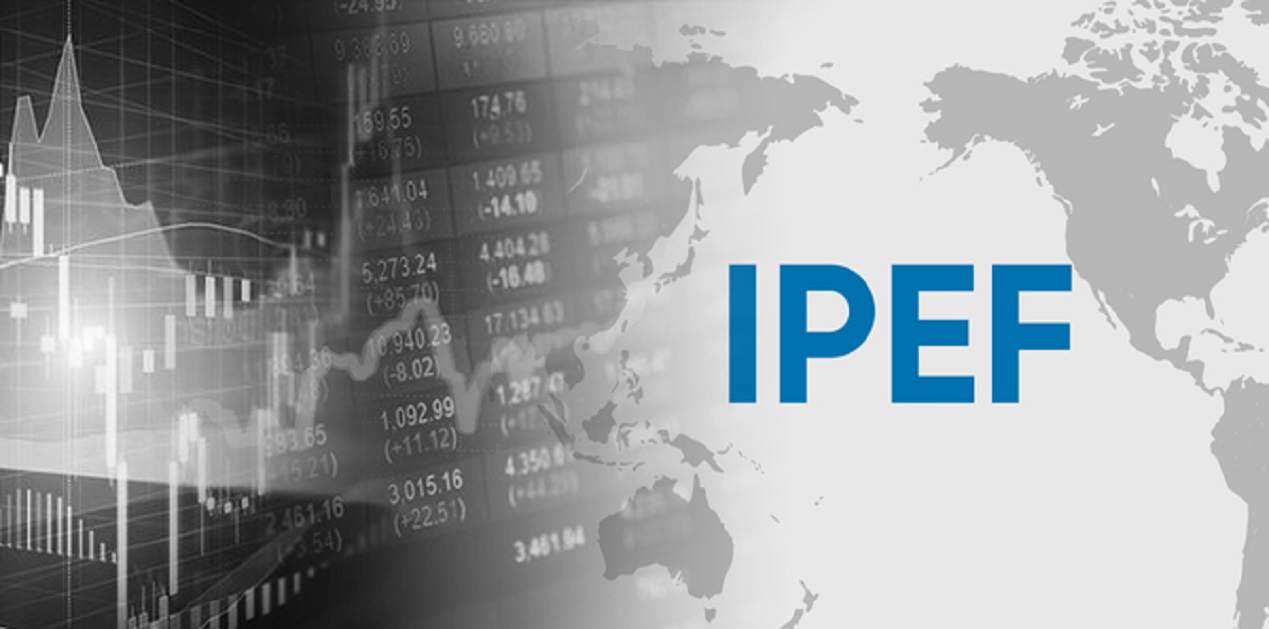During the QUAD summit held in Tokyo, in May 2022, US President Joe Biden along with leaders from 13 countries signed on an agreement referred as Indo-Pacific Economic Framework (IPEF). The participants of the agreement share same values and interests and strive to achieve a common goal of economic prosperity in the Indo-Pacific region. They are committed to a free, open, fair, inclusive, interconnected, resilient, secure, and prosperous Indo-Pacific region. The joint statement of the agreement sets out plan for “collective discussions toward future negotiations”, with a focus on four pillars: (a) Trade (b) Supply Chain (c) Clean Energy, Decarbonisation, Infrastructure and (d) Tax and Anti-Corruption[1]. Following the launch of the pact, several scholars expressed that the initiative is an alternative to Regional Comprehensive Economic Partnership (RCEP) and Comprehensive and Progressive Agreement for Trans-Pacific Partnership[2] (CPTPP). India being a signatory to the agreement is expected to accrue a huge benefit from this pact. The pact will help India to deepen its engagement with the Indo-Pacific region. It is in this connection, this article attempts to assess the possible benefits that India could gain from the arrangement. This article also aims to provide a comparative analysis of the IPEF with RCEP and CPTPP.
How is it different from CPTTP and RCEP?
The IPEF is widely claimed to be the US attempt to regain its foothold in the region that it is losing to China especially after it left CPTPP and the enforcement of RCEP which is often termed as China-dominated mega trade block. But the basic difference among the IPEF, CPTTP and RCEP lies in their foundations. The IPEF is not a free trade agreement while RCEP and CPTTP are two of the largest and most comprehensive trade agreements in the world covering a wide range of issues that primarily aims to reduce the tariffs among the members and offer larger market access to their participants. China is the largest economy among the RCEP members while its membership request is pending in the CPTPP. Against this, IPEF offers no preferential market access to its participants neither it outlines any tariff reduction plan. As mentioned earlier, trade is one of the pillars of the IPEF and its proposition is not based entirely upon trade issues. Besides that, IPEF also does not feature the primary attributes of a trade agreement such as rules of origin, investment protection etc. The IPEF does not have any dispute settlement mechanism, which is central to most economic arrangements, including RCEP and CPTPP. While IPEF will advance the issue of labour and environment standards, the resilience of the supply chain; which are not mentioned either in RCEP or CPTPP.
How will India benefit from IPEF
India is the only country from the South Asian region to participate in IPEF. Joining IPEF reflects India’s renewed interest in economically engaging with the Asia and the Pacific region and its commitment to bringing growth and prosperity to the region. As an emerging leader in the region, India will play a significant role in the success of this regional initiative. At the same time, India would also benefit from the initiative in several ways.
Building resilient supply chains is one of the goals of the IPEF. It will complement India’s ambition to integrate its economy with the global supply chain network through various efforts including Resilient Supply Chain Initiative. India can divert its import sources and find substitutes among IPEF members to import raw materials and other products. For instance, Malaysia could become a source of computer chips, while Australia can fulfil India’s demand for minerals and energy needs. This would significantly reduce India’s dependence on China for these raw materials. Thus by increasing or diverting trade of raw materials with the IPEF members can provide a cushion against any kind of supply shocks in the future[3].
Increased trade with IPEF participants will boost India’s trade relationship with the region. India also had an interim on Economic Cooperation and Trade Agreement with Australia in April 2022. However, there has been a change in Australian government afterwards. Engagements through the IPEF could deepen India-Australia renewed ties. IPEF membership can prove to be an effective platform for India to assert a proactive stance on bilateral and regional trade agreements.
India’s aim to become a US$ 5 trillion economy by 2025 where trade is a major element of growth would get a boost from this initiative as it proposes to expand trade among the participants. India’s ambition to become a digital economy hub is complemented by the primary goals of the IPEF. The IPEF would also extend its support to India’s plan to become a net-zero economy as it promises to work closely on climate related issues.
Possible Challenges
The IPEF is primarily US led and driven by its interests. A White House statement mentions, ‘The United States is an Indo-Pacific economic power, and expanding U.S. economic leadership in the region is good for American workers and businesses — as well as for the people of the region. IPEF will enable the United States and our allies to decide on rules of the road that ensure American workers, small businesses, and ranchers can compete in the Indo-Pacific[4]’. Evidently, it attaches very high importance to the US interests. Therefore, there remains an apprehension of IPEF becoming a tool for promoting and serving the US interests at the expense of others.
IPEF may also pose a few technical challenges to India. India’s current policy regarding e-commerce, data flow, data localisation etc might not be in sync with the policies of the US and some other members of the pact. India may face difficulties in reviewing its labour laws and environmental standards as envisaged by IPEF. This is so as some of the members such as the USA and Singapore have high standards related to these areas as compared to India.
Concluding Remarks
The IPEF will remarkably advance the prosperity of the Indo-Pacific region. It will substantially strengthen the existing efforts such as QUAD and AUKUS. For India, it is undoubtedly a great opportunity to deepen its engagement with the Indo-Pacific region and live up to its commitments. The IPEF also provides great prospects for India to accrue huge economic benefits. However, it is unclear at this moment as to how much benefit the framework will deliver back to member nations and advance the agreement’s four primary goals.
End Notes :
[1]MEA (24 May 2022). Statement on Indo-Pacific Economic Framework for Prosperity
https://www.mea.gov.in/bilateral-documents.htm?dtl/35353/Statement+on+IndoPacific+Economic+Framework+for+ProsperityAccessed on12.6.22
[2]Palit, A. (25 May 2022) The Indo-Pacific Economic Framework: An Inclusive Quad-plus Initiative”, Institute of South Asian Studies, ISAS Brief No. 934, https://www.isas.nus.edu.sg/papers/the-indo-pacific-economic-framework-an-inclusive-quad-plus-initiative/Accessed on 12.6.22
[3]Gupta, P. (4 June, 2022). Indo-Pacific Economic Framework for Prosperity: What IPEF holds for India. Financial Express. https://www.financialexpress.com/opinion/indo-pacific-economic-framework-for-prosperity-what-ipef-holds-for-india/2547344/ Accessed on 22.6.22
[4]The White House (23 May, 2022) Fact Sheet: In Asia, President Biden and a Dozen Indo-Pacific Partners Launch the Indo-Pacific Economic Framework for Prosperity. https://www.whitehouse.gov/briefing-room/statements-releases/2022/05/23/fact-sheet-in-asia-president-biden-and-a-dozen-indo-pacific-partners-launch-the-indo-pacific-economic-framework-for-prosperity/ accessed on 21.6.22
(The paper is the author’s individual scholastic articulation. The author certifies that the article/paper is original in content, unpublished and it has not been submitted for publication/web upload elsewhere, and that the facts and figures quoted are duly referenced, as needed, and are believed to be correct). (The paper does not necessarily represent the organisational stance... More >>
Image Source: https://file.mk.co.kr/meet/neds/2022/05/image_readtop_2022_469332_16536278305056760.jpg











Post new comment